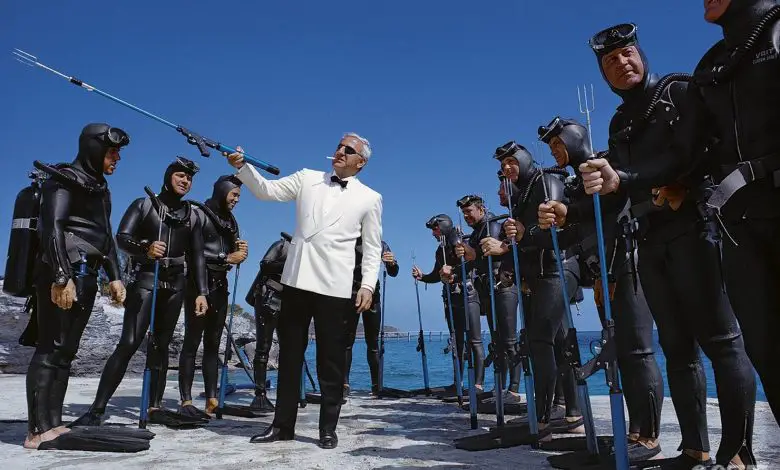Why Diving is Crucial for James Bond?

Diving is a crucial aspect of James Bond’s thrilling adventures, playing a pivotal role in his missions as a renowned spy. From infiltrating underwater hideouts to gathering valuable intelligence, Bond’s diving skills allow him to navigate the depths of the ocean with finesse. In this article, we will explore why diving is indispensable for James Bond and how it contributes to his success in the world of espionage.
Diving provides Bond with a stealthy approach, allowing him to maneuver undetected and gather vital information from submerged locations. Equipped with state-of-the-art SCUBA gear and specialized training, Bond’s underwater excursions often involve combat, survival skills, and the use of advanced gadgets. As we delve into the world of James Bond, we will discover the significance of diving in shaping his character and aiding him in his daring escapades.
Key Takeaways
- Diving is crucial for James Bond’s missions, providing him with a stealthy approach and access to valuable intelligence hidden beneath the surface.
- Bond undergoes specialized training in various aspects of diving, including combat techniques and the use of advanced SCUBA gear and weaponry.
- His diving missions showcase the risks, challenges, and real-life inspirations associated with underwater espionage.
- The cinematic portrayal of diving in Bond movies adds excitement, visual splendor, and highlights the importance of ocean conservation.
Diving: A Key Element of Espionage
Diving as a Stealthy Approach As a secret agent, Bond frequently encounters missions that involve infiltrating underwater hideouts, retrieving valuable artifacts, or investigating submerged locations. Diving allows him to approach these targets discreetly, using the underwater environment as cover. With the ability to swim silently and remain undetected, Bond gains a tactical advantage over his adversaries.
Underwater Intelligence Gathering Diving provides Bond with access to crucial information and secrets hidden beneath the surface. He can gather intelligence by examining underwater installations, studying marine life patterns, or recovering submerged documents. These discoveries often serve as valuable clues in unraveling intricate plots and foiling the plans of the villains he faces.
Combat and Survival Skills In James Bond movies, diving is not merely a means of transportation but also a tool for combat and survival. Bond’s training equips him with combat techniques tailored for underwater encounters, such as hand-to-hand combat, the use of specialized weaponry, and evasion tactics. These skills enable him to engage in underwater battles and escape life-threatening situations with finesse.
The Technical Gear of a Diving Spy
SCUBA Equipment To excel in his underwater missions, James Bond relies on state-of-the-art SCUBA (Self-Contained Underwater Breathing Apparatus) equipment. This gear allows him to breathe underwater, regulate buoyancy, and navigate efficiently beneath the surface. Bond’s SCUBA gear is often equipped with advanced features, including built-in communication devices, high-powered propulsion systems, and integrated weaponry.
Underwater Vehicles Bond’s adventures beneath the waves wouldn’t be complete without the aid of cutting-edge underwater vehicles. Whether it’s the iconic Lotus Esprit car that transforms into a submarine or a futuristic mini-submersible, these vehicles enable Bond to explore vast underwater territories, escape from dangerous situations, and execute daring maneuvers.
Specialized Gadgets As an espionage expert, Bond is known for his array of high-tech gadgets, and diving missions are no exception. From miniaturized rebreathers for extended underwater stays to underwater cameras and sonar devices, these gadgets enhance his diving capabilities, providing him with crucial information and a competitive edge against his adversaries.
Real-Life Inspirations and Influences
Real-World Diving Missions While James Bond’s diving adventures may seem far-fetched, they draw inspiration from real-life diving missions conducted by intelligence agencies and military organizations. Throughout history, divers have been employed to recover classified information, salvage sunken vessels, and carry out covert operations. Bond’s aquatic escapades reflect the real-world applications of diving in intelligence and military contexts.
Oceanic Settings in Bond Movies The James Bond film series has often showcased stunning underwater scenes set in exotic locations around the world. These captivating visuals not only serve to enhance the cinematic experience but also highlight the importance of preserving our oceans and marine ecosystems. Bond’s diving escapades bring attention to the beauty and fragility of underwater environments, fostering a greater appreciation for ocean conservation efforts.
FAQ
1. Why is diving important for James Bond’s missions?
Diving is essential for James Bond’s missions due to its stealthy and covert nature. Underwater environments provide him with a unique advantage, allowing him to approach targets undetected. Diving enables Bond to gather valuable intelligence, retrieve crucial artifacts, and infiltrate hidden underwater hideouts. By utilizing his diving skills, Bond gains a tactical edge over his adversaries and increases his chances of mission success.
2. What kind of specialized training does James Bond undergo for diving?
James Bond undergoes extensive training in various aspects of diving to prepare for his missions. His training includes mastering SCUBA diving techniques, underwater combat skills, and the use of specialized diving gear and weaponry. Bond also learns how to navigate underwater environments, maintain proper buoyancy, and adapt to the challenges posed by different underwater conditions. This comprehensive training ensures that Bond is well-prepared to handle the complexities of underwater missions.
3. How does diving contribute to James Bond’s survival in dangerous situations?
Diving plays a crucial role in James Bond’s survival during dangerous situations. When faced with life-threatening scenarios, Bond can utilize his diving skills to escape pursuers, evade capture, or hide underwater. His ability to swim silently and remain undetected underwater provides him with an effective means of evading his enemies. Additionally, Bond’s combat training in diving allows him to defend himself and engage in underwater battles, increasing his chances of survival in high-pressure situations.
4. What kind of equipment does James Bond use for diving?
James Bond relies on advanced SCUBA equipment to excel in his diving missions. His gear includes specialized breathing apparatuses, buoyancy control devices, and communication systems. Bond’s diving equipment is often equipped with cutting-edge features, such as integrated propulsion systems and built-in weaponry. Additionally, he utilizes underwater vehicles, such as submarines and mini-submersibles, to explore underwater territories and carry out his missions with efficiency and effectiveness.
5. Are there any real-life inspirations for James Bond’s diving adventures?
Yes, James Bond’s diving adventures draw inspiration from real-life diving missions conducted by intelligence agencies and military organizations. Throughout history, divers have been involved in covert operations, underwater reconnaissance, and salvage missions. The risks, challenges, and skills portrayed in Bond’s aquatic escapades reflect the experiences of real-world divers engaged in similar activities. While Bond’s missions may be fictional, they showcase the important role diving plays in intelligence and military operations.
6. How does diving contribute to the cinematic experience of Bond movies?
Diving scenes in Bond movies add an element of excitement, adventure, and visual splendor to the cinematic experience. The underwater settings provide breathtaking visuals, showcasing the beauty and mystery of the underwater world. These scenes often involve high-stakes action, intense encounters, and intricate plots, further captivating the audience. Diving serves as a narrative device that showcases Bond’s versatility and showcases the sheer audacity of his missions.
7. What are the risks associated with diving in James Bond’s missions?
Diving in James Bond’s missions comes with inherent risks, including the danger of encountering hostile forces, underwater traps, or hazardous marine life. The depths of the ocean can be unpredictable, with factors such as strong currents, limited visibility, and extreme pressure posing challenges to Bond’s safety. Furthermore, the use of advanced diving equipment and gadgets introduces the risk of technical malfunctions or reliance on limited resources. Bond’s training and preparedness are crucial in mitigating these risks and ensuring his survival.
8. How does diving contribute to Bond’s intelligence-gathering capabilities?
Diving provides Bond with unique opportunities for intelligence gathering. Underwater installations, sunken ships, and hidden documents can reveal valuable information that may be vital to unraveling plots or identifying enemy organizations. Bond’s ability to navigate underwater environments, examine marine life patterns, and recover submerged objects allows him to acquire intelligence that would otherwise remain hidden. By utilizing his diving skills, Bond expands his access to critical information, enabling him to stay one step ahead of his adversaries.
9. What role does diving play in promoting ocean conservation?
Through Bond’s diving adventures, the movies bring attention to the beauty and fragility of underwater environments, thereby fostering a greater appreciation for ocean conservation. These cinematic portrayals raise awareness about the importance of preserving marine ecosystems, promoting sustainable practices, and protecting underwater habitats. By showcasing the wonders of the ocean, Bond movies encourage viewers to become more conscious of their impact on the environment and take active steps to safeguard our oceans.
10. Can diving be considered an essential skill for real-life spies?
While real-life spies may not encounter scenarios as elaborate as James Bond’s adventures, diving can still be considered a valuable skill in certain intelligence and military operations. Underwater access provides unique opportunities for surveillance, reconnaissance, and covert infiltration. Divers can retrieve objects, gather intelligence, and even disable enemy underwater installations. While the extent of diving’s importance may vary depending on the mission and context, it remains a skill that can enhance the capabilities of real-life operatives in specific scenarios.
Conclusion
Diving is an indispensable skill for James Bond, allowing him to explore the depths of the ocean and carry out his missions with unparalleled precision. From utilizing advanced diving gear and gadgets to mastering underwater combat techniques, Bond’s expertise in diving sets him apart as a spy. Through his daring underwater adventures, Bond not only captivates audiences but also sheds light on the significance of preserving our oceans and marine ecosystems.
As we immerse ourselves in the world of James Bond, we gain a deeper appreciation for the art of diving and its crucial role in espionage. The combination of underwater stealth, intelligence gathering, and combat prowess makes diving an essential component of Bond’s arsenal. So, the next time you watch a Bond movie, remember the importance of diving in shaping the fate of our favorite secret agent, and let yourself be enthralled by the captivating underwater world that Bond fearlessly explores.









